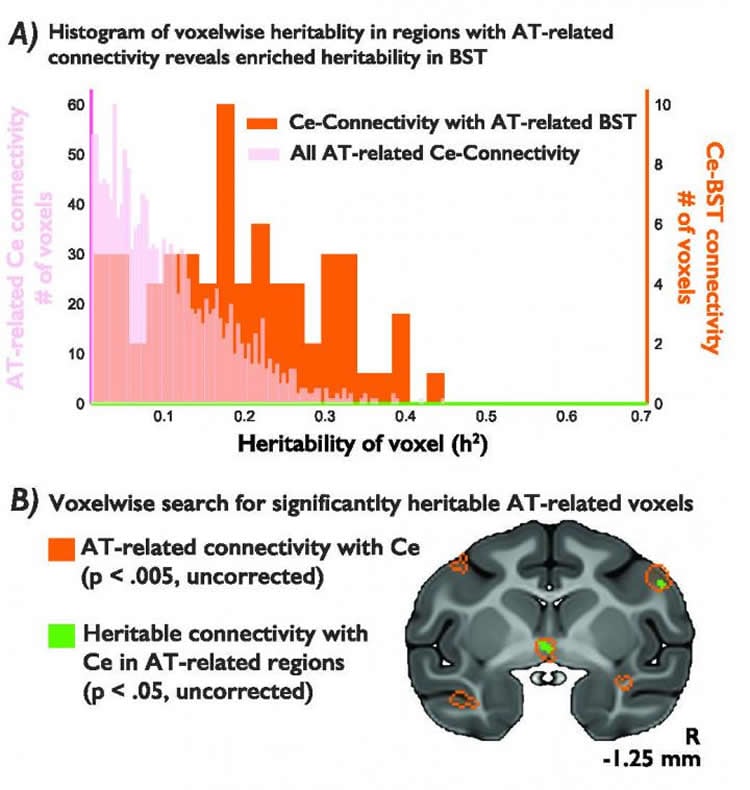Summary: A new study reports individual differences in connectivity between areas of the brain associated with fear and anxiety are heritable.
Source: SfN.
Individual differences in the connectivity between regions of the brain involved in fear and anxiety are heritable, according to a large study of hundreds of related monkeys published in Journal of Neuroscience. The research provides new insights into the risk and development of anxiety disorders.
Using brain imaging techniques regularly employed in human studies, Ned Kalin and colleagues found that functional connectivity between two regions of the central extended amygdala is associated with anxious temperament in pre-adolescent rhesus macaques.
As extreme early-life anxiety is a risk factor for anxiety disorders and depression in humans, further study of this nonhuman primate model may yield new directions in the prevention of these disorders in at-risk children. This would represent an improvement over current treatments, which address symptoms rather than the mechanisms underlying the development of these disorders.

Funding: California National Primate Research Center, National Institutes of Health, NIH/National Institute of Mental Health, University of California Davis, University of Maryland College Park funded this study.
Source: David Barnstone – SfN
Publisher: Organized by NeuroscienceNews.com.
Image Source: NeuroscienceNews.com image is credited to Fox et al., JNeurosci (2018).
Original Research: Abstract for “Functional connectivity within the primate extended amygdala is heritable and associated with early-life anxious temperament” by Andrew S. Fox, Jonathan A. Oler, Rasmus M. Birn, Alexander J. Shackman, Andrew L. Alexander and Ned H. Kalin in Journal of Neuroscience. Published July 30 2018.
doi:10.1523/JNEUROSCI.0102-18.2018
[cbtabs][cbtab title=”MLA”]SfN”The Heritability of Anxiety.” NeuroscienceNews. NeuroscienceNews, 30 July 2018.
<https://neurosciencenews.com/genetic-anxiety-9634/>.[/cbtab][cbtab title=”APA”]SfN(2018, July 30). The Heritability of Anxiety. NeuroscienceNews. Retrieved July 30, 2018 from https://neurosciencenews.com/genetic-anxiety-9634/[/cbtab][cbtab title=”Chicago”]SfN”The Heritability of Anxiety.” https://neurosciencenews.com/genetic-anxiety-9634/ (accessed July 30, 2018).[/cbtab][/cbtabs]
Abstract
Functional connectivity within the primate extended amygdala is heritable and associated with early-life anxious temperament
Children with an extremely inhibited, anxious temperament (AT) are at increased risk for anxiety disorders and depression. Using a rhesus monkey model of early-life AT, we previously demonstrated that metabolism in the central extended amygdala (EAc)—including the central nucleus of the amygdala (Ce) and bed nucleus of the stria terminalis (BST)—is associated with trait-like variation in AT. Here, we use fMRI to examine relations between Ce-BST functional connectivity and AT in a large multi-generational family pedigree of rhesus monkeys (n = 170 females and 208 males). Results demonstrate that Ce-BST functional connectivity is heritable, accounts for a significant but modest portion of the variance in AT and is co-heritable with AT. Interestingly, Ce-BST functional connectivity and AT-related BST metabolism were not correlated and accounted for non-overlapping variance in AT. Exploratory analyses suggest that Ce-BST functional connectivity is associated with metabolism in the hypothalamus and periaqueductal gray. Together these results suggest the importance of coordinated function within the EAc for determining individual differences in AT and metabolism in brain regions associated with its behavioral and neuroendocrine components.
SIGNIFICANCE STATEMENT
Anxiety disorders directly impact the lives of nearly 1 in 5 people, accounting for substantial worldwide suffering and disability. Here, we use a nonhuman primate model of anxious temperament (AT) to understand the neurobiology underlying the early-life risk to develop anxiety disorders. Leveraging the same kinds of neuroimaging measures routinely used in human studies, we demonstrate that coordinated activation between the central nucleus of the amygdala and the bed nucleus of the stria terminalis is correlated with, and co-inherited with, early-life AT. Understanding how these central extended amygdala regions work together to produce extreme anxiety provides a neural target for early-life interventions with the promise of preventing life-long disability in at-risk children.






